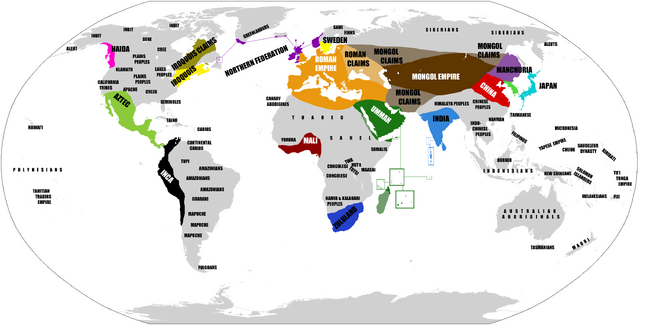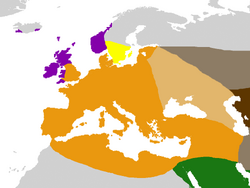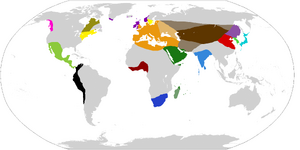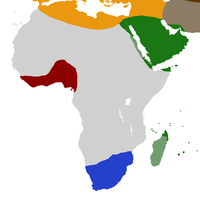
A map of Naught Earth, with major countries' borders. Minor countries; countries without certain borders; and unorganized cultures are also listed. Click the map to see words more clearly.
Naught Earth is an Alternate History timeline set in around 1890; based mainly on the idea that Ancient Rome and China maintained the same technology they had in around 0 BCE; but the rest of the World continued to develop as normal. However, one other important change to this scenario is that Rome didn't fall to the barbarians, and the Roman empire was never forced to split between East and West. Three other small changes are that the Inca, Tu'i Tonga, and Saudeleur Empires (which all fell (or were falling) before Europeans arrived) all remain powerful, and don't fall.
The world in this timeline developed as follows:
By Region[]
Europe[]

The major countries of Europe:
As the Roman Empire never fell, it continued its expansions; and began encroaching deeper into Africa, the Near-East, and Scandinavia. However, troubles in Germany, Poland, and Eastern Europe; coupled with the harsh conditions of the North; meant that the Roman Legions found it very difficult to conquer Scandinavia. By the time they had reached modern Sweden and Norway, the Viking culture had developed fairly well; and the Norse peoples managed to defend themselves against Roman attacks, while also conducting raids down into Europe. Eventually, Rome managed (through violence and bribery) to make the area of Southern Sweden into a client-state; but the rest of the Norse held off.
Meanwhile, Norwegian sailors had begun their epic Voyages of Discovery, reaching Ireland (which the Romans still had not discovered), Iceland, Greenland, and even Newfoundland. The various Celtic peoples of Scotland, Wales, Cornwall, and western England began to band together to fight the Romans; and after they struck an alliance with Ireland, Norway, and the Norwegian colonies; they formed their own loosely-organized country named the Northern Federation. Eventually, the Romans were ejected from the areas controlled by this Federation, though they continued trying to claim them back.
The Northern Federation inspired other anti-Roman rebellions, though only one other group was as successful as the Northerners - the Ummah Caliphate in the Middle-East (see below).
Religion in Europe stayed very varied, with the Roman Polytheism staying dominant throughout the Empire. However, Judaism gradually became more and more accepted, and eventually Jews suffered very little discrimination in the more 'civilized' parts of the Empire. Christianity, too, eventually became legal (though much later than Judaism), and while it never became as widespread as it is in the real world, it did begin spreading as far as Missionaries could get, in the Roman Empire and beyond. The various Native beliefs of peoples around the Empire also became much more respected - mostly as an attempt to keep the Imperial Citizens satisfied, so they wouldn't rebel against the Emperor. Only Islam remained illegal, because of the extensive attempts by Muslims to unite everyone of their faith under one Flag, and into one independent country (see Middle-East, below).
Asia[]

A map of Asia, showing major countries.
Rome - Mongol Empire - China - Manchuria - Korea - Japan - India - Ummah Caliphate
Without the European Imperial presence, Asia took a very different turn. China, Japan, Korea and Manchuria were locked into a permanent state of war, with short alliances and quick betrayals constantly happening. However, this war was not particularly large - especially considering the large populations and advanced weaponry available to all sides.
It was this massive war which made conquest so easy for the Mongol Empire under Genghis Khan, who took advantage of the petty squabbles between the Eastern countries to 'divide and conquer'. Manchuria fell first, though the Manchu people proved to be the fiercest resistance fighters after their conquest; then Korea, which could not cope with the vastness of the Mongol army; China fell next, after valiant defense of its various cities. Japan (which had developed a fairly powerful navy due to its long war with enemies across the sea) managed to hold off the feeble Mongol warships for a while, but once the Mongols landed, they found it easy to overwhelm the strictly-regimented (but un-inventive) Japanese troops, who had never fought such a wild, reckless enemy before.
When the new Khan turned his attentions elsewhere, the Manchu quickly eradicated the few Mongols who had stayed to 'protect' Manchuria. The Manchu leaders realized that only by freeing China, Korea and Japan, and banding their forces together, could they hope to stop the Mongols returning to destroy them - so the Manchu hordes reluctantly set about helping the Chinese, Japanese and Koreans, whom they had always warred against. Together, the four countries defeated the Mongols who tried to re-conquer them; and entered into a very fragile alliance.
Meanwhile, the Mongol Army was much more successful elsewhere - conquering much of Siberia, even through the harsh Winters; as well as reaching as far West as Poland (which was under Roman control). The Mongols found the Roman defense to be almost impenetrable, and eventually decided to temporarily abandon hopes of conquering Europe. They conquered much of Western China (which was not actually under Chinese control at that time); and all of Central Asia; but drew their border along Eastern Iran, Northern India, and Southern China; due to their inability to deal with the climate of the Iranian Desert, Indian Jungle, and the Himalaya Mountains, respectively.
The areas of Russia which the Mongols did not invade (the Russian Southwest) became a vast expanse of farmland, claimed by Rome, but never occupied by Roman Soldiers. Almost nobody lived there, despite the pleasant climate, and the fact that the area was perfect for raising livestock. The locals were very peaceful, and were crucial to the long, elaborate trade route which connected the Roman Empire all the way to Japan. Horses from this area were prized, and sought after by people from across Eurasia.
India flourished. Due to the lack of European and Islamic interference, it was the Indians themselves who benefited from the lucrative resources their country held. After a visit from Arabic Explorers, who introduced many ship-building techniques, the people of Southwestern India became expert seafarers, charting much of Indonesia; many the islands of the Indian Ocean; and rough outlines of the West Coast of Australia and the Coast of Africa. Indian seafarers even opened a trade route between Portugal and India, though this route was rarely used, due to the inability of most Indian ships (and all European ships) to survive the journey.
Indonesia, without the visits from Muslims and Europeans and the intellectual benefits that they brought, remained a fairly simple society. The population was always fairly small, considering the large area that the islands cover, and most people lived in small fishing villages on the coast.
Religion in Asia was incredibly varied, with Taoism prominent in China; Shamanism in Manchuria; Confucianism in Korea; and Buddhism and Shinto in Japan. The Mongols followed their own traditional religion, though many converted to Buddhism later on. The Southwestern Russians followed Slavic Religions; the Indians were predominantly Hindu or Buddhist, though a very small Muslim community existed in the South; and in Indonesia, traditional tribal faiths stayed popular. Due to the fact that Islam did not exist in Punjab (and was very rare in India altogether), Sikhism (which was partly inspired by Hindu and Muslim teachings) was never founded. Christian Missionaries came to Asia from the Roman Empire, and (though they had no success with the Mongols) established several Missionary Schools and Communities throughout India, China, Outer China*, Korea and Japan. There was also Missionary activity in Manchuria and Indo-China, which had some success, though not as much as in other parts of Asia; as well as some attempts to convert the Himalayan peoples, which had almost no success; as the Himalayans were generally very devout Buddhists and Bön - successful Christian conversions were mostly in the Himalayan Hindu community.
(* Outer China refers to the people who live in parts of OTL China, but in Naught Earth China is much smaller, so they are technically not in China in TTL.)
Middle East[]

A simplified map of the World.
Though Christianity was fairly rare in this timeline, it did exist in Europe and the Near-East, so people in Arabia were aware of Abrahamic religion. This meant that Muhammad existed in this timeline, as well, and was also able to found Islam.
Although much of Arabia was a part of the Roman Empire by Muhammad's time, the people there did have limited Religious Freedom, so they followed the traditional Arabian shamanism at this time. However, Islam became a very popular religion in this area, and eventually there were no Shamanists left. Islamic scholars taught that the people of their faith should unite under one banner, and form into their own country - the Ummah Caliphate. This idea proved very popular, but was considered dangerous by the Roman Authorities, and ultimately ended with Islam being repressed.
However, the Muslim community began a rebellion, and were able to win independence for Arabia and the nearby, predominantly-Muslim areas such as southern Egypt. This area then became the Ummah Caliphate, and quickly developed into a scientific leader, surpassing even Rome in some areas. The Arabians also proved to be master seafarers (arguably better than the Norwegians), and began extensively exploring the Indian Ocean and the Coast of Africa. They established small ports on Zanzibar, Madagascar, and countless smaller islands - some of which grew into big cities.
Though the Ummah Caliphate decided that they would allow total religious freedom, due to their dislike of the Roman banning of Islam, almost all of the local population were Muslim, except for small Jewish and Hindu minorities; as well as a few Native religions in some of their colonies. Despite this Religious Freedom, the Ummah government was intolerant of Missionary activity. Christian Missionaries often used different methods in the Middle-East than they did elsewhere, as they had to make their services look as much like an "ordinary" church as possible.
Africa[]

A Map of Africa, showing Mali in red; Zululand in blue; Ummah in green; Rome in orange and the Mongolian Empire in brown.
Due to Roman Control of practically all of North Africa (and Arabic control of the rest), the Tuareg were the only independent Africans outside of Sub-Saharan Africa. They ran the legendary Trans-Saharan Trade, trading exotic goods to the Romans and Arabs; in return for advanced technology to the other Africans. The Tuareg became incredibly rich from this, though they were not the richest group in Africa.
The Malians were not only the richest in Africa, but were probably the richest in the World, controlling much of West Africa, and more gold than all of Europe combined. Their army was largely composed of very light spearmen, archers and javelineers; who were excellent at harassing enemies, but consistently failed in full-on battles. However, the Malians had a very unexpected weapon up their sleeve: horses. After acquiring a herd of purebred, Arabian horses through the Trans-Saharan Trade Route, the Malians worked hard to create a very strong cavalry force, which surprised many of their other African enemies, who were not used to such creatures.
Using this cavalry, the Malians conquered much of the Sahel (grassland between the Sahara and the Jungle), but were unable to take their horses further South because of the Tse-Tse flies, which quickly killed off most livestock in Southern Mali; so the Malian army was less successful further South, but still managed to conquer areas from Sierra Leone through Cameroon. Malian Emperor Mansa Musa once made a journey all the way to Arabia, in order to learn more about the world. The gold he donated, on a whim, along the way was enough to devalue the price of Gold for 11 years.
In Central Africa, East Africa, and the Congo Jungle, very little was changed in this timeline - except that no European powers came to these areas, so the people there kept their traditional lifestyle.
In the South, Madagascar became a part of the Ummah Caliphate, though the Arabs only founded a few towns on the coast, and made up less than 5% of the island's population.
The Zulu, without hindrance from Dutch and British settlers, conquered vast areas of land - stopped only by the Congo Jungle and the Namib and Kalahari Deserts. By 1890, they have started a campaign in Southeast Africa, which offers no Natural Boundary against the Zulu. The people of the Namib and Kalahari Deserts remain blissfully unaware of the outside world, and live as they always have done.
Religion in Africa was basically un-unified, with no 2 groups following the same faith. Each people had their own religion, though Arabic presence in Northeast Africa and Madagascar brought Islam to those areas. The Malians and Zulu also spread their own religions within their own Empires; and there was some Christian influence across the Continent's North Coast.
North America[]

Iroquois Confederacy (Iroquois Claims) - Northern Federation - Haida Empire - Aztec Empire
Other than the Peoples of Western Alaska, who regularly interact with the peoples of Eastern Siberia; the only contact that the Americas have with the outside world is the Northern Federation's small colonies in Newfoundland. At first they were hostile to the Natives, but eventually got on friendly terms with them.
The three largest groups in North America were by far the Iroquois Confederacy, the Aztec Empire, and the Haida Empire (though the latter was far less influential than the others).
The Iroquois began in Up-State New York as a fairly powerful group of 5 Nations - Cayuga, Mohawk, Oneida, Onondaga and Seneca, but shortly incorporated the Tuscaroa as well. Without European interference, their power only grew, and their combined armies proved almost unstoppable. They conquered much of New England, New York State, parts of New Jersey and Pennsylvania, and the nearby parts of Canada. The only group they failed to conquer was the Susquehannock, another powerful nation further South. After a long war, which ended in a stalemate, the Iroquois accepted the Susquehannock as their seventh Nation.
This was immediately followed by a long line of Seneca High Chiefs, who proved to be fairly peaceful, and greatly benefited Iroquois society; but following a few attacks on Northern Iroquois villages by Mi'kmaq, Maliseet, and Abenaki peoples (among others), the Iroquois selected a Mohawk War Chief to lead them, and began a ferocious campaign of conquest Northwards - ultimately reaching all the way to Northern Quebec. The Iroquois never reached Newfoundland, and therefore never encountered Europeans.
The Aztec, like the Iroquois, benefited greatly from not having to deal with Europeans, and completely conquered all of North America south of the USA. They also reached North into Arizona, New Mexico, and California, but found the desert of these areas almost completely uninhabitable. Because of this, the Aztecs maintained only limited control over these areas, and focused on trying to expand further south, into South America, but came into conflict with the Inca Empire, resulting in the bloodiest war in the history of the Americas, and one of the bloodiest in the world.
The Haida Empire began as a small nation in the Queen Charlotte Islands - or Haida Gwaii - off the Western Coast of Canada. They were masters at crafting canoes, creating some of the largest and sturdiest in the world, and used these to raid neighboring tribes. However, as their population gradually grew, they became more violent towards these other tribes, and began not just raiding, but actually going to war to conquer them. The Haida's power could not compare to that of the Iroquois or Aztecs, but they were still a significant group in their own area.
The Native Americans of Northern Canada, Alaska, the American West, Central and Western Canada, the Central USA, and the Southeastern USA were all unaffected by this timeline, except that they obviously did not acquire horses, or encounter Europeans, because there was never an 'Age of Discovery'.
Like in Africa, Religion in North America varied from tribe to tribe.
South America & The Caribbean[]

Map of South America. The Inca Empire is in black; and the Aztec Empire is in green.
In South America, the Inca Empire (or Tahuantinsuyo) flourished, conquering a vast portion of the continent. They claimed all of the Andes, much of Chile (except for the South), Northern and Western Colombia, and Northwestern Venezuela. Despite their highly successful and powerful army and tactics, the Inca remained hindered by the Amazon Rain forest, and the seemingly unbeatable tribes who dwelled within it. However, their society and technology developed much further while they sustained their conquests, and at the time of their first meeting with the Aztecs, the Inca were probably the most advanced nation in the Americas.
It was in Southern Panama that the Aztecs and Incas first collided, as the Aztecs launched an attack on the small Incan town of Intitambo. The village was, naturally, destroyed by the Aztec invaders, but the Inca Emperor in Cuzco quickly heard the news, and sent a large part of his fearsome army to retaliate. The meeting of these two forces proved to be the beginning of one of the bloodiest wars in history.
In the Caribbean, the Arawak people were almost all killed by the Caribs, who went on to control all of the Lesser Antilles; but the Taíno, on the other hand, managed to defend their homes in the Greater Antilles against Carib raiders. The Caribs' warlike society eventually imploded, and each separate island fell into its own Civil War. On some islands, the war ended, and the inhabitants went on to live in an idyllic, peaceful society. However, other islands had long, drawn-out wars, resulting in most of the population being killed and most of the resources wasted. The Taíno, in contrast to this, developed a very successful society, and suffered very few wars.
Elsewhere in South America, the Mapuche became large and successful throughout Patagonia and the Southern regions of South America. Their society became very advanced, with a functioning Democracy and Gender Equality both implemented. The Amazonian Tribes and the people of Tierra del Fuego remained in their traditional lifestyles.
Similar to North America and Africa, most tribes of South America had their own Religion. However, the Inca usually forced their religion on their conquered peoples.
Australia and the Pacific[]
Many areas of the Pacific, which did not encounter each other in our universe, 'discovered' each other in this universe.
Australian and Tasmanian aboriginals remained in their traditional lifestyles, as did the people of Papua New Guinea, Melanesia, and much of Micronesia and Polynesia. In New Zealand, the Maori society flourished, though tribal warfare was still endemic to the area.
Tahiti, however, became a strong power, conquering several nearby islands. The Tu'i Tonga Empire, as it wasn't destroyed by the 3-Way Tongan Civil War, remained the Pacific's dominant power, stretching across the great Ocean. In Micronesia, the Yapese Empire became the only country which could truly rival Tonga in this area; and the Saudeleur Dynasty of Pohnpei became the Pacific's economic and technological hub. Hawai'i, despite being completely isolated from the rest of the world, also became a successful society.
Finally, the Rapanui people of Easter Island, managed to rebuild their civilization. After their Moai (or stone head) culture failed, they entered the Tangata Manu (or bird man) phase, to try to re-construct their society. This eventually proved successful, as seabirds began nesting on the island again, bringing with them seeds. Slowly, trees began to re-grow, and ultimately, the islanders learned to manage the delicate ecology of their home.
Religion in the Pacific was different for each different group, but most Polynesian religions were very similar; as were Melanesian, Micronesian and Austronesian religions.
Trade Routes[]
Several Trade Routes existed in this Timeline:
- Northern Federation Route - Linked Norway with the British Isles, Iceland, Greenland and Newfoundland
- Silk Road - Linked the Roman Empire with Japan; through the Mongols, China, Manchuria and Korea
- Trans-Sahara Route - Operated by the Tuareg in North Africa; linked Mali with the Roman and Islamic areas of North Africa
- Oceanic Route - Operated by the Arabians in the Indian Ocean, ran between Arabia, India and Madagascar; and included the islands in between
- Pacific Imperial Route - Connected the Yapese and Saudeleur empires in Micronesia with the Tongan and Tahitian empires in Polynesia
- Tahiti Route - Ran between the various islands of the Tahitian Trading Empire
- Trans-American Route - Linked the Iroquois with the Aztecs (through several tribes in between); and then on to the Inca, and even the Mapuche
- Tibetan Route - Connected India to China
- Oriental Route - Connected India to the Mongols, and then on to Rome
- Aleut Route - Between the Aleuts of Eastern Siberia and the Aleuts of Western Alaska
